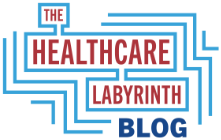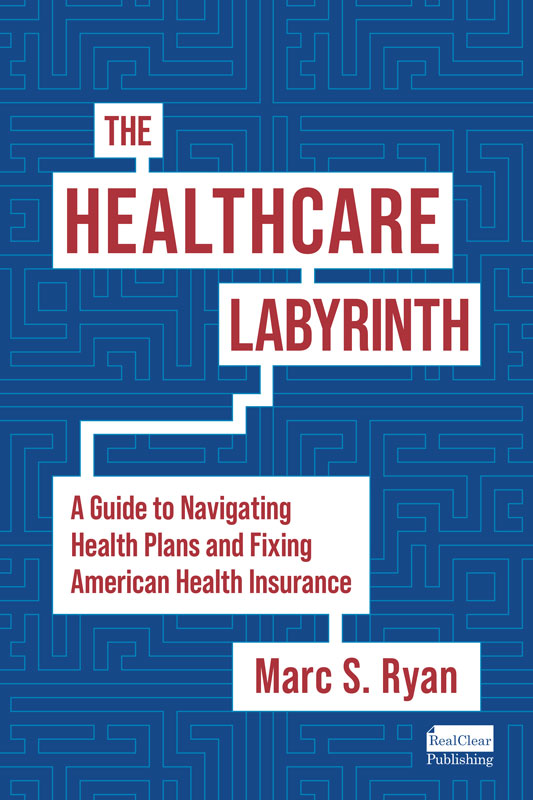This blog is one in a three-part series that digs into my modest proposal for healthcare reform published at this site on May 27, 2024. See that blog here to review my proposal thoroughly: https://www.healthcarelabyrinth.com/a-modest-election-year-proposal-for-healthcare-reform/ .
Much of my proposal is taken from my book, The Healthcare Labyrinth, available at this site and through leading bookseller websites. It is available in print, ebook, and audiobook forms.
—
The importance of price reform
In my “A Modest Election-Year Proposal For Healthcare Reform” blog on May 27, 2024, I stressed that the cornerstones of reform are three key tenets – driving affordable universal access, reforming price, and pivoting to care management from our obsession with utilization management. I am going to start with price reform in this blog and in later blogs cover the other two tenets.
In the May 27, 2024 blog, I argue that we need to fundamentally tackle price in the system. With limited exceptions, price in our healthcare system is not based on any semblance of cost.
Take hospital prices: Hospitals create so-called charge masters that do not represent costs in any meaningful way. Reimbursement in Medicare and the commercial world is deeply discounted from these charge masters. Hospitals keep these charge masters at exorbitantly high prices simply to have leverage in commercial negotiations and to perpetuate the myth that government programs radically under-reimburse. This may be the case in Medicaid in some states, but it is not accurate overall.
The same system exists within the broader provider community, which has provider billed charges that substantially exceed real costs.
The huge price tags that providers put on their services hurt in a number of ways.
- First, by nature, it means unreasonable costs in the system. Most provider charges are well above reasonable costs.
- Second, it leads to greater inflation. Providers tend to inflate their exorbitant prices each year in an effort to drive negotiated prices. Inflating high prices tends to force negotiated prices up each year. A simple illustration: If a provider has a $100 billed amount for a service and inflates that by 7% per year, the provider asks for most or all of the $7 in negotiations each year. Let’s say a provider reimburses that billed charge at 50%. If you assume the inflation rate is even fair, inflation on that amount is $3.50. But plans tend to have to cover a piece or all of the other $3.50 to satisfy providers and meet network adequacy. While true inflation hits the system, much of the increase is based on this flawed pricing system.
- Third, such a system promotes inefficiency across the board. No incentives exist in this system to reform how a provider does business.
- Fourth, high prices also force up out-of-pocket costs for Americans. High prices force plans to demand more in premiums and out-of-pockets costs. These go up each year in two ways: Insurers are forced to increase deductibles and cost-sharing in the benefit design (i.e., increase the deductible, copays and percentage co-insurance). In addition, the percantage co-insurance increases in terms of sheer dollars as provider prices rise.
Uniform pricing and related reforms
In the 5/27 blog, I argue we should adopt a uniform national and/or regional model for healthcare pricing as other nations do. This would be across all healthcare lines of business. This would be a direct response to the effects of hospital monopolies, exorbitant price masters, and high rates in general. This also would bring better price transparency, stop surprise billing, and more.
This proposal works in and out of the United States. In the rest of the developed world (socialized medicine, single payer, and even most universal access countries), an all-payer and all-line-of-business rate system, with uniform fee schedules, is practiced. This is not unlike what is done in the traditional Medicare fee-for-service (FFS) program, which helps private plans drive better overall rates in the system in Medicare. Some Medicaid states have experimented with provisions that require good-faith negotiations to occur between health plans and providers as to rates. If such talks fail, a rate tied to prevailing plan reimbursement or a low Medicaid FFS system rate is automatically adopted.
A think tank, The Bipartisan Policy Center, suggests that exorbitant hospital rates in uncompetitive areas could be tackled by pegging maximum rates to (1) the average Medicare Advantage rate or (2) the average commercial rate, depending on how competitive a market is. As well, the center would bar anti-competitive contracting standards (e.g., contracting with every provider owned by a hospital or system rather than specific providers the plan needs).
How much could this save? I am not a fan of creating a public option, which is a plan sponsored or run by the government in the Exchanges. But the Urban Institute did a study on the effects of the uninsured rate and costs if a public option was created in the nation and used rates that were pegged to Medicare rates (or just above it in some scenarios). While having a public option for just the non-group markets did little to reduce costs or the uninsured rates, it did save substantial sums if group market employers chose the public option for employees.
- If some employers took advantage, the uninsured rate could drop by up to 1.7M and employers would save up to $143 billion per year.
- If all employers were in a public option plan, the uninsured rate would drop by up to 1.6M and employers would save up to $224 billion per year (all employer scenarios had add-ons only to the Medicare rates).
Again, my reason for citing this study is not because I think a public option is a good idea, but to show how an all-payer and all-line-of-business rate system with uniform fee schedules would save a great deal. In many ways, that would “top out the savings scale” as prices likley would not fall to prevailing Medicare rates. But at any rate, price would be driven down dramatically and huge savings would accrue to the system as a whole and patients paying cost-sharing and deductibles.
From here, health plans could tweak rates, including adopting value-based care payment models. They would largely compete on quality and satisfaction. Administrative costs would drop dramatically with uniform rates. Uniform pricing would take away all of the disparate pricing – between regions of the country, within regions of the country, between hospitals, between payers, and even within hospitals and payers.
A “1% Steps For Health Care Reform” proposal
Is my proposal too big and too fast? If so, a prominent healthcare academic reform group, “1% Steps for Health Care Reform,” has a proposal that would begin the steps toward my proposal. It notes that over the last three decades, provider markets have become increasingly consolidated and prices for care in the commercial line of business have steadily increased. Its proposal could save 5.7% of commercial healthcare spending or 1.8% of total healthcare spending. Not counting annual inflationary cap savings (also suggested), this saves about $68 billion of commercial healthcare spending.
“1% Steps” proposes the following:
- At the local market level, introduce “backstop” price caps for in-network and out-of-network rates, which bars prices above the lower of (a) 500% of the 20th percentile of local prices or (b) the 75th percentile of such service-market price percentiles nationally.
- Introduce price growth regulation that limits provider price growth and allows higher growth caps for relatively cheaper services and lower growth gaps for more expensive providers.
- Have appropriate federal and state reporting to monitor and enforce the policy.
The proposal says that physician office visits at the median 20th percentile commercial price approximate Medicare reimbursements. The median 20th percentile of inpatient payments is approximately 133% of Medicare reimbursements. The price caps would be around five times Medicare. About 4.5% of cases and 84.3% of providers would be impacted.
What the proposal does is take excess out at the very top end. I would argue more needs to be done to drive commercial provider payments down. So, the proposal is not that radical as a start. But it still saves a great deal.
Drug price reform
We also have to tackle drug price reform. While I do not intend to go deep here, some reforms include:
- Patent and Food and Drug Administration (FDA) process reforms, including generic and biosimilar promotion.
- Streamlining, reforming, and adopting better price transparency in the drug supply channel.
- Elimination of rebates and/or requiring all reductions from gross price be passed through at the point of sale.
- Drug price reimbursement reforms.
- Pharmacy benefits manager (PBM) reform, including barring spread pricing and requiring transparent models.
- Drug price negotiation and international reference pricing across all lines of business. The Inflation Reduction Act’s (IRA) Medicare drug price negotiations provide a foundation that mirrors what other developed countries do for their entire systems.
Related reforms
I would note other needed reforms impacting price include:
- Broad price transparency regulation.
- Adoption of site neutral payments. The same service should be paid the same rate across all places of service. Hospitals should not be allowed to have higher rates or charge facility fees for services that can be performed in ambulatory settings, physician offices, or at home.
- Value-based payments and care.
- Consumerism and personal responsibility, including awareness of using the most appropriate site of care. While we want to maintain reasonable cost-sharing so as not to create barriers to care, it is not unreasonable to create a system where a low-cost, quality provider or drug is covered with reasonably modest cost-sharing. However, choosing another provider within a place of service or a more expensive setting might mean you pay 100% (or a large portion) of the difference in cost. This is what is referred to as reference pricing, an upper limit a payer will reimburse at, with the consumer covering the additional amount.
- Interoperability and data-sharing between providers and payers.
- Reforms to rein in aberrant provider practices, which is a big part of the up to 25% of healthcare spending that is wasteful, abusive, or fraudulent.
- Provider benchmarking, where providers are analyzed for both their efficiency and outcomes.
- Meaningful policies on fraud, waste, and abuse (FWA).
That is it. Simple, right? Well maybe not, but moving toward price reform is critical as far too much of our gross domestic product (GDP) is taken up by uncontrolled healthcare costs. Next blog: the necessary pivot from an obsession with utilization management to true care management.
Sources and Additional Reading:
https://bipartisanpolicy.org/wp-content/uploads/2020/02/43530-BPC-FHC-Report-Proof.pdf
#healthcare #healthcarereform #pricereform #providers #hospitals #healthplans #medicare #medicaid #pricetransparency #siteneutral #transparency #drugpricing #ira #interoperability #vbc #valuebasedcare
— Marc S. Ryan





